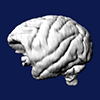-
-
sample data

|
-
-
-
sample data

|
-
sample publication

|
|
Ipsilateral intracortical connections of physiologically defined cutaneous representations in areas 3b and 1 of macaque monkeys: projections in the vicinity of the central sulcus.
J Comp Neurol. 1995 May 15;355(4):508-38. Burton H, Fabri M.
This study examined cortical connections of areas 3b and 1 in 17 macaque monkeys in reference to regional somatotopography. The fluorescent retrograde tracers Fast Blue and Diamidino Yellow and the anterograde tracer Rhodamine Dextran were injected into closely related cutaneously responsive sites in primary somatosensory cortex, e.g., adjacent digits. Supra- and infragranular layers in nearly all studied areas contained labeled pyramidal cells. Labeled infragranular cells predominated at the fringes of a distribution where cells labeled from different tracer injections in the same brain intermixed more. All topographical regions across area 1 have reciprocal connections with areas 4, 3a, 3b, 1, 2, and 5. Intrinsic connections within area 1 and between it and area 2 are greatest; those with area 3b are less. Intrinsic connections within area 3b exceed all other nearby projections from this area which reciprocally connects with areas 3a, 1 and 2. Connections appear topographically organized, including those with poorly mapped regions, like area 5. These connections link representations of neighboring skin and skip map regions that include disjoint dermatomal areas. Connections from adjacent digit representations overlap; however, double-labeled cells were not found. Distal and proximal digit zones mostly interconnect within an area. Intrinsic connections spread further in area 1 than in area 3b, thereby joining more disparate topographical zones than interareal connections, which project more homotopically. The domain over which the map in somatosensory cortical area I (SI) dynamically changes following intracortical microstimulation (Recanzone, Merzenich and Dinse, Cerebral Cortex 2:181-196, 1992) may depend on the range of intrinsic connections observed in this study. The extent of connections between cortical areas was less than expected and this challenges the hypothesis that these connections directly create receptive field enlargements.
Neuroanatomical Connectivity References
|
|

